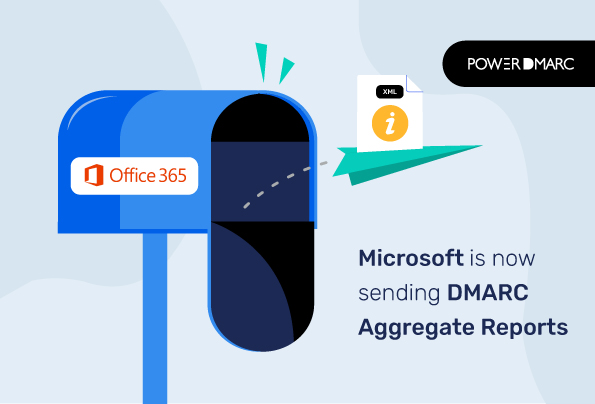The long-awaited roll-out is finally here! Microsoft is sending DMARC RUA aggregate reports to their users and chances are you may have not noticed it. Microsoft DMARC aggregate reports are sent from the following email address: dmarcreport@microsoft.com. The raw Microsoft DMARC aggregate file is sent in standard XML format. Microsoft has finally embraced DMARC reporting, which essentially means that now Hotmail, Outlook, Live, and msn.com users will be able to enjoy the various benefits of Microsoft DMARC aggregate data.
Processing Microsoft DMARC Aggregate Data
PowerDMARC report analyzer parses the Microsoft DMARC aggregate data into an organized format that would aid you in processing it more efficiently.
To help users avail of the benefits of aggregate report data sent by Microsoft, PowerDMARC’s DMARC report analyzer has been preconfigured to receive their reports directly on the platform. All that users need to do is add their domains on the PowerDMARC platform along with configuring the DMARC DNS record, while we process and present the reports in an easy and understandable way. Here you will find:
- DMARC aggregate data sent from Hotmail, Outlook, Live, and msn.com recipient addresses parsed from the raw XML file format into simple and readable information organized into tables
- PowerDMARC is preconfigured to bypass RFC violations, enabling us to receive and parse your DMARC data sent by Microsoft servers without you having to worry about it
- Register multiple domains, monitor your email channels and make DNS changes directly from the dashboard with actionable buttons at your fingertips
- Filter results into assorted categories such as per result, per sending source, per organization, per country, geolocation, and detailed stats or search results per domain on the search bar
- Get deeper insights into the performance of your emails, and quickly pick up on attempts at domain spoofing, impersonation, or fake emails being sent using your Microsoft business domains. You will also be able to analyze any SPF, DKIM failures from your sending sources.
Displayed above is a screenshot of our DMARC aggregate reports per organization displaying DMARC RUA data sent from Microsoft.
Issues you might be facing while handling Microsoft DMARC Aggregate Reports on your own
Microsoft DMARC Aggregate Emails are not RFC-Compliant
The primary issue that users have been facing with these emails containing reports being sent by Microsoft is that they do not conform to the RFC specifications for internet emails. While RFC 5322 chapter 2.1.1 clearly states that a line of characters must not exceed 78 characters, the BASE64 attachment data in these Microsoft DMARC aggregate emails is a continuous line without proper line breaks that exceeds the 78 character limit. The resultant RFC violation is the reason why most of these emails are landing up in the user’s rejection log instead of being delivered to their inbox.
Raw XML files are hard to read
Much like the DMARC data sent by all reporting organizations, the raw RUA file is in extensible markup language (XML) that is difficult to read and understand.
Prerequisites for Receiving Microsoft DMARC RUA
To receive aggregate reports for your domains on outlook.com, you need to ensure that you have a valid PowerDMARC record published on your DNS, along with a defined DMARC policy. Reporting organizations will then send aggregate report data to your specified web server or email address. This will help you gain visibility and DMARC compliance on your third-party email vendors which you otherwise have no control over.
Protect your domains on Microsoft Office365 and others by starting your email authentication journey today. Get on board with a free DMARC trial or schedule a DMARC demo, and explore the benefits of implementing a robust email security posture at your organization!
- SMTP Yahoo Error Codes Explained - May 1, 2024
- SPF Softfail Vs Hardfail: What’s the Difference? - April 26, 2024
- FTC Reports Email is a Popular Medium for Impersonation Scams - April 16, 2024
